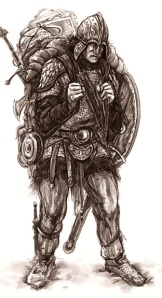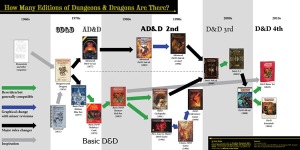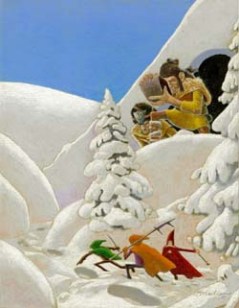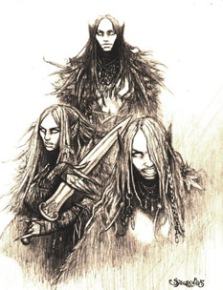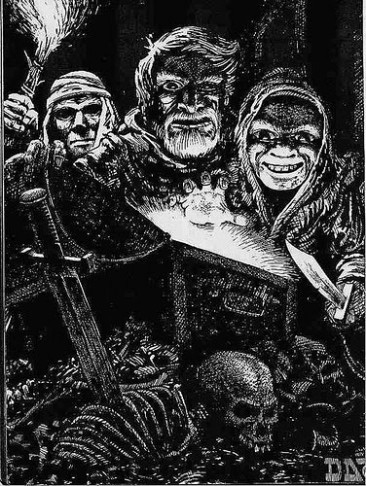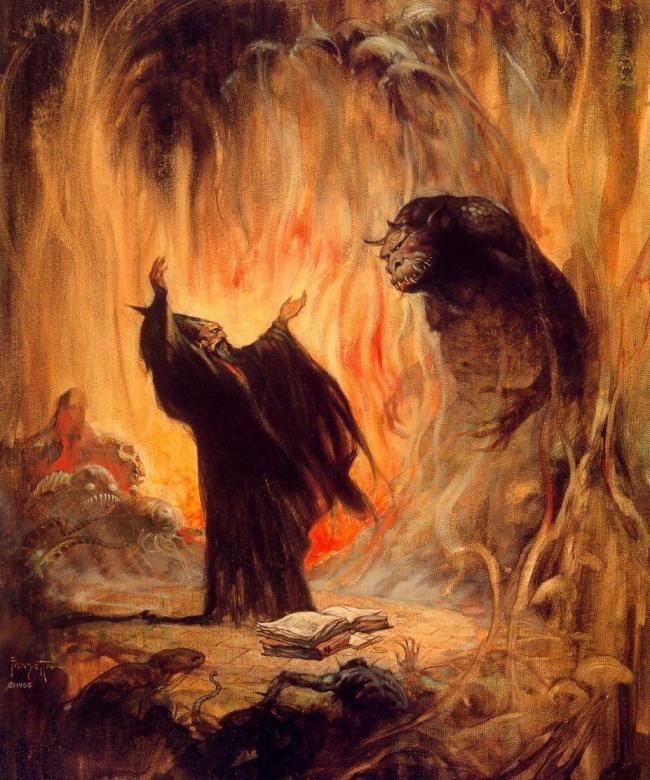
As promised, we're beginning with the beginning - the Little Brown Books of the original white box. Okay, yeah, yeah, you might call "the beginning" Chainmail or Braunstein or what have you, but this is the first thing released into the world as "Dungeons & Dragons", though not yet as a "roleplaying game". I'm no James Malieszewski when it comes to the history of the game, but for this analysis, I'm more concerned with differences in the products as rules manuals that I can use now than I am in their history. I will touch on it briefly (as well as I'm able) in order to speculate on what changes tell us about the play experiences the designers were trying to address. But enough jibber jabber, let's jump in.
Men & Magic
"Here is something better!" First off, a word about formatting and graphic design (in the sense that Zak S. talks about it) - there isn't any. Well, that's not true, there's formatting of the sort some guys could do as hobbyists in 1974, and yes, there's some charm to 'slap it together yourself' aesthetic, but it's a terrible in-play reference. Material isn't very clearly grouped, there's no index, and rather important concepts get a mention and that's it. I honestly think a lot of the reputation OD&D has for being "incomplete" or needing high levels of referee involvement and prep stems from the fact that it's not formatted in a way where you can pick it up and use it as an instructional manual. As I've mentioned before, I started out with the purist vision of playing actual OD&D, but after the first session of character creation and brief play, I made the switch to Swords & Wizardry Whitebox on account of its being easier to reference (and I actually have dreams of reformatting that in a more useful way, but it's still loads easier to refer to in play than the LBBs). With these books, you have to read, re-read, internalize, interpret and otherwise work to make the text work for the game. That's okay, and there may even be some virtue in that, but overall I tend to come down on the position that RPG texts should facilitate learning the game and referencing the rules in play first, and being engaging and thought provoking works a distant second. The engagement and thought provocation ought to come out in play rather than the rules. Given how rarely RPGs acquire new players by someone picking up a book out of the blue and getting an impression of it from that book alone, I think that's a fair set of priorities. That tangent out of the way, let's take a look at Men & Magic section by section, even if they are inadequate as organizational tools.
Foreword
There's not much applicable to the rules here (as you'd expect), other than the emphasis on campaign play and the exhortation that these rules are intended for people with imagination. I like that. As much as I admire a "scientific" approach to game design, where rules are crafted to attempt to guide players to the desired play experience, there's a lot to be said for openly putting the onus on the players to use the toolkit provided.
Introduction, Scope, Preparation
So, despite my smack talking about OD&D's value as an instructional manual, it does go into charmingly specific detail on recommended equipment: "Sheet Protectors (heaviest possible)." It also gives a piece of advice that remains good to this day, around which I've built the entire Fellhold campaign - start small and build up detail as you go. Other than that, it emphasizes the expectation that the referee will house rule like the devil, and the flexibility of the rules, from the prehistoric to the futuristic. I like to think of this as acknowledging the then latent potential of roleplaying games as a form combined with some understandable boosterism for a fledgling product.
Characters, Abilities, and NPCs
What I find most interesting about the characters, abilities, and non-player characters sections is what they say about the play that produced them. The character races that have become canonical are presented more in the sense of "hey, here's the stuff we already figured out, but go ahead and make up something else if you want". Acquiring followers and armies, and their morale and loyalty scores get a lot of detail, showing the wargaming roots. I like that abilities are "determined" rather than "created" - I think James Maliszewski hit on that on Grognardia, this notion that your character is randomly picked from all the possible characters in the world rather than crafted to your whim. I'm still confused about the "use one stat for another at a 3 for 1 rate for experience purposes only", but I don't think I'm alone in that.
Equipment
Some of the prices here don't show the same concern for medieval verisimilitude that later editions get to. Though not listed here, it's a running joke in my game that tents, as priced in Swords & Wizardry Whitebox, costs something like a year's soldiering wages. Great fun was had by me in describing the giants' new loin cloths after they chased the party out of camp.
"Alternative" Combat System
Here we have the combat system that turned into D&D's defining mechanic. The tables are a little confusing, or rather the ways they try to save space by giving Magic Users and Clerics as relative values to Fighting Men. Deep in my heart of hearts, I'm a THAC0 man myself, so I'm considering switching over, originalism be damned. It's interesting to me that AC only goes down to 2 and up to 9. I'll have to check out the Supplements to see when that was expanded. The 10 to -10 spread is imminently logical, but it does divorce the idea that AC represents particular armor types. That was probably inevitable, and possibly desirable, considering the diverse uses AC was already being put to to describe different monsters that are hard to hit for reasons other than wearing particular types of armor.
The saving throw matrix is also kind of terrible.
Spells
Level 1 spells have a lot of overlap between Magic Users and Clerics, but after that they start to diverge quite a bit. Clerics get "Remove Curse" as a level 3 spell instead of level 4, and obviously have all the healing spells. Otherwise, perhaps what's most surprising about the spells is how little many of them have changed. Effects and mechanics are remarkably consistent for many of them, and despite the profusion of spells available in later editions, most of the most used and iconic ones are right here.
Next up in the series will be "Monsters & Treasure".
For rules, here is the method I used recently for filling out "adventure sites" as determined with the previous rules adapted from Welsh Piper (which generated too many adventure sites and too many large outposts for the vibe I was going for, but would have been good for creating a dense, interesting small map)
Adventure Site Generation
Take stuff from a good source like Dyson Logos, Hexenbracken or the Kraal, or the Tome of Adventure Design, or your favorite published setting material or:
01-60: Monster Lair
- Roll Random Encounter Chart for Terrain type
61-70: Surface Ruins
- Use outpost generation rules to determine size and type of ruins, then either roll random encounter chart for monsters there, add intelligent but dangerous inhabitants, or come up with something to make it worthwhile
71-80: Some Kind of Inhabited/Dangerous/Interesting Place besides an outpost
81-90: Small 1 Level Dungeon
- Generate Randomly, Wing it, or Grab a map
91-00: Full Dungeon
- Generate randomly, grab a map, or go whole hog and make it
